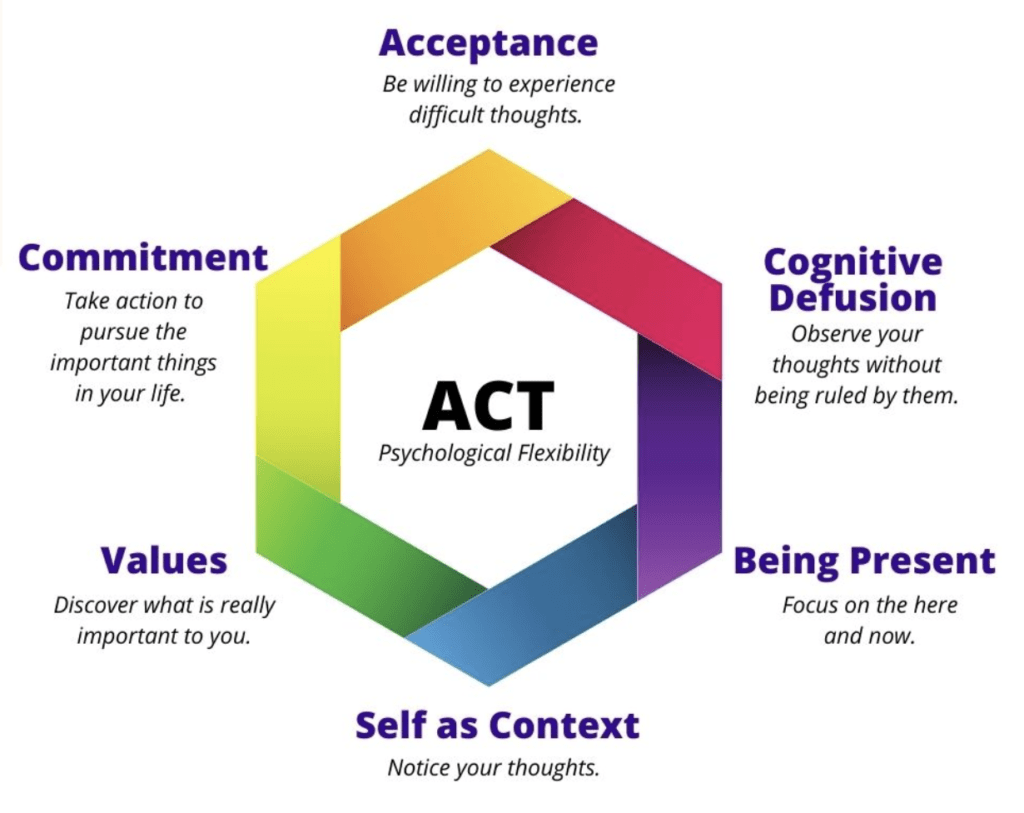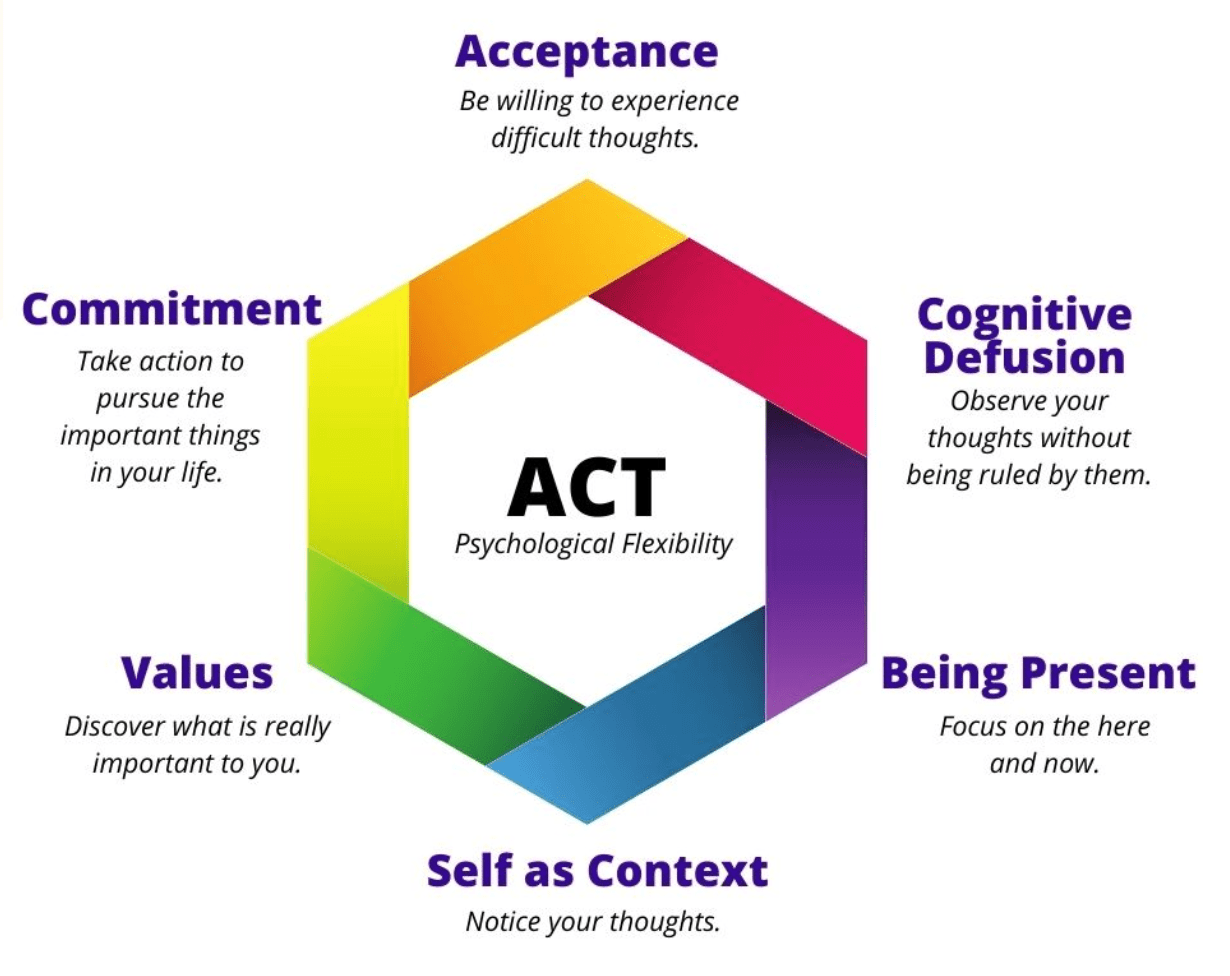Acceptance and Commitment Therapy (ACT), may continue to be my favorite therapeutic modality for the remainder of my career. ACT intuitively makes sense to me. As I explain to my clients when introducing this type of therapy, Acceptance and Commitment Therapy doesn’t seek to reduce emotional pain, but to find meaning in spite of it. Pain is unavoidable and happiness is not sustainable- tenants of ACT support these basic concepts of human life.
Acceptance and Commitment Therapy was introduced in 1986 by Steve Hayes and draws from Buddhism, mindfulness, and Relational Frame Theory. Although I won’t attempt to summarize all components of ACT in one blog post, the most comprehensive explanation I can offer is by way of taking you through the ACT hexaflex. The hexaflex is a visual reference that references the six components of Acceptance and Commitment Therapy.
The ACT Hexaflex

Acceptance
Acceptance is best explained by the statement: “I don’t like it. I don’t want it. But, I accept it.” Acceptance in ACT emphasizes human’s innate dislike of change, and affirms the need to feel unpleasant feelings and events. For example, in treating anxiety, ACT therapists don’t immediately look to minimize the frequency and duration of symptoms, but letting go of the struggle to change the sensation. Unexpectedly, this practice often leads to a decrease in symptoms. Experiential avoidance is the opposite of acceptance, which is what happens when people resist inevitable unpleasant feelings or situations.
Cognitive Defusion
Defusion is my favorite ACT concept. Acceptance and Commitment Therapy offers various techniques to try to minimize the stories we tell ourselves about our lived experience. The human brain makes up all kinds of stories and seeks to compare like experiences, which often leads to unnecessary stress. Some techniques include: (1) labeling the process of thinking, “I’m having the thought that I’m a failure” (2) mimicking, making light of the thought (i.e.: stating out loud to oneself: “I’m the stupidest person I know” in the tone of Arnold Schwarzenneger) or (3) singing the thought in the form of song (i.e. “I’ll always fail forever and ever” to the tune of Mary had a Little Lamb).
Don’t knock them ’til you try them! Singing “I will worry, always, forever” to the tune of Donna Lewis’s 90s hit, “I Love You, Always Forever” has often helped me interrupt the cycle and move on to a more productive activity than ruminating.
Being Present
Boil some tea in a glass kettle or a pot with a glass lid. Watch the 5 minute process of boiling water with interest. Next, get a tea bag. Smell the tea, inhaling deeply. Put the tea bag in a mug and watch the tea brew as you pour the hot water over it. Blow cool air on the tea. Take a sip.
While most of us cannot make our lives work with this monk like level of presence, slowing down for just 5 minutes can be incredibly soothing. I find sitting meditation for long periods of time quite difficult, as I know many of you do. Task oriented mindful activities like the above tend to do the same trick, increasing awareness and decreasing stress.
Self as a Context
Self as a context involves disattachment. You are you, your thoughts are your thoughts, your feelings are your feelings, your experiences your experiences. Your thoughts, feelings, and experiences aren’t who you are. As you can see in the middle of the hexaflex, “psychological flexibility,” or the ability to adapt to changing thoughts, feelings, and circumstances, is the central goal of ACT. Practicing self as a context by noticing and not reacting increases our capacity for psychological flexibility.
Values
ACT is, above all, a value led practice. All the other ACT techniques lead to value identification, which then leads to commitment (see below). One activity an ACT therapist may engage you in is processing your values in a variety of life domains like: intimate relationship, friendships, civic duty/community, and physical health. Further, this exercise includes rating each domain’s importance in your life. A value led framework can be helpful in the therapeutic process for years to come. For example, if you rate physical health as a 9/10 but you haven’t exercised in two weeks, it may be time to get back into your routine. ACT is not shame based, we do not exercise because it’s the right thing to do, but because it is an important part of what we do.
Commitment
ACT uses the acronym FEAR to help mitigate the difficulty between identifying our goals and taking committed action towards them. F (fusion), E (excessive expectations), A (avoidance), R (resisting change). An ACT therapist will help you create a framework in which tolerating discomfort feels like a useful function in order to live a value aligned existence. An ACT therapist will also help you define measurable short, mid, and long term goals which are value led, not based on any societal or family standards.

